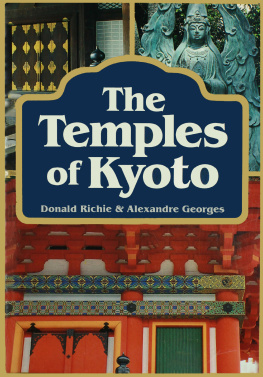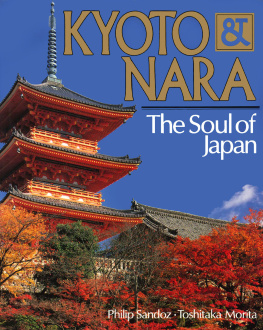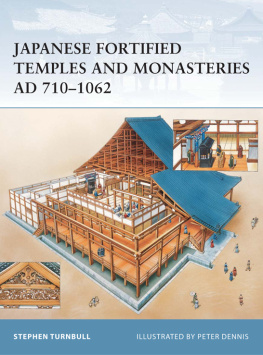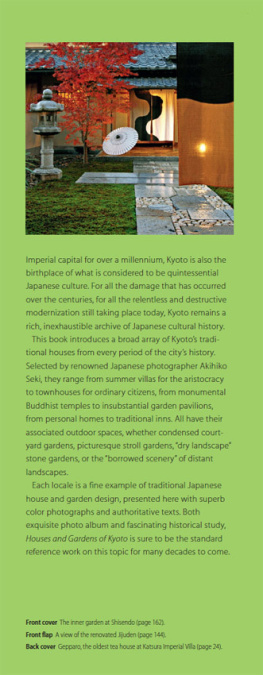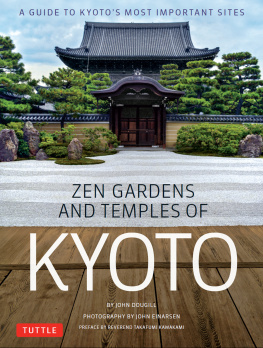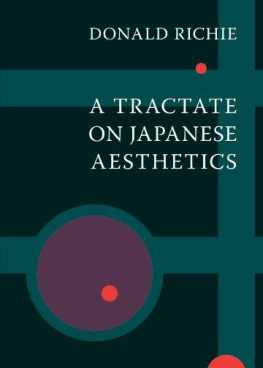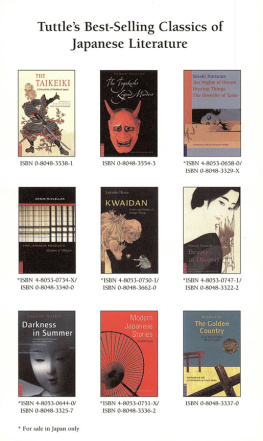Acknowledgments
"this book has many sources. Most are indicated in the following bibliography. I owe much to these authors and their writings, though many of the ideasparticularly the more questionable onesare my own. I am also indebted to the eminent historian, Paul Varley, who kindly read oyer this manuscript for me and offered thoughtful and necessary suggestions. Of these I have gratefully availed myself. The mistakes remaining are all of my own doing.
Bibliography
Agency for Cultural Affairs. Japanese Religion: A Survey. Kodansha International, Tokyo, 1972
Anon. The Tale of the Heike. (H. McCullough, trans.). Stanford University Press, Stanford, 1988
Ashihara Yoshinobu. The Hidden Order. (1986). Kodansha International, Tokyo, 1989
Alex. William. Japanese Architecture. Prentice-Hall, Int., London, 1963
Blaser, Werner. Japanese Temples and Tea Houses. Dodge Publishers, New York. 1956
Durston, Diane. Old Kyoto. Kodansha International, Tokyo, 1986
Frederic, Louis. Daily Life in Japan. (1185-1603), (Eileen Lowe trans., 1972). Charles E. Tuttle. Tokyo, 1973
Fukuyama Toshio. Heian Temples. Weatherhill/Heibomha. Tokyo, 1976
Futagawa Yukio, The Roots of Japanese Architecture. Harper & Row; New York, 1963
Guest, Harry, ed. Traveller's Literary Companion: Japan. Inj Print, Brighton, 1994
Hall in the muromachi Age. University of California Press, Berkeley. 1977
Hanayama Shinsho. A History of Japanese Buddhism. Dendo Bukyo Kyokai, Tokyo, 1960
Hisamatsu Sen'tchi. A Vocabulary of Japanese Literary Aesthetics. Centre for East Mian Cultural Studies, Tokyo, 1963
lhara Saikaku. Koshoku bhidai Otoko (Life of an Amorous Man). (1682), (Kenji Hamada, trans.). Charles E. Tuttle, Tokyo, 1964
Ito Teiji. Wabi/Sabi/Suki. Cosmo Corporation. Tokyo, 1992
Kawabata. Y. Koto (The Old Capital). (J. Martin Holdman, trans., 1987). Charles E. Tuttle. Tokyo, 1988
Kama no Chomei. Hojoki (The Record of a Ten-Foot-Square Hut). (Burton Watson, trans ). Shambhala Publications, Inc., Boston, 1994
Kato, Shuichi. Japan: Spirit and Form. (Leza Lowitz, trans ). Charles E. Tuttle, Tokyo. 1994
Keene, Donald. Anthology of Japanese Literature. (1955). Charles E. Tuttle, Tokyo. 1956
_____, Essays in Idleness (The Tsurezuregma of Kenko). (Donald Keene, trans., 1967). Charles E. Tuttle, Tokyo, 1981
_____. Travles of a Hundred Ages, Charles E. Tuttle, Tokyo, 1989
_____. World within Walls. Charles E. Tuttle, Tokyo, 1976
Kidder, J. Edward, Japanese Templet Bijutsu-shuppamha, Tokyo, 1968
Kipling, Rudyard. From Sea to Sea . (1900). AMS Press, New York. 1970
Lethaby, William. Architecture. Mysticism and Myth. George Braziller, New York, 1975
Martin, John and Phyllis. Kyoto: A Cultural Guide. Charles E. Tuttle, Tokyo, 1994
Mishima Yukio. Kinkaku-ji (The Temple of the Golden Pavilion). (Ivan Morris, trans., 1959). Charles E. Tuttle, Tokyo, 1959
Morris, Ivan. The World of the Shining Prince. (1964). Charles E. Tuttle, Tokyo, 1978
Mosher, Gouveneur. Kyoto: A Contemplative Guide. Charles E. Tuttle, Tokyo, 1964
Murasaki Shikibu. Genji Monogatari (The Tale of Genji). (Ed Seidensticker, trans., 1976). Charles E. Tuttle, Tokyo, 1991
Paine, R.T./Soper, A. The Art and Architecture of Japan. (1958). Yale University Press, New Haven, 1981
Palevsky, Nick/June Kinoshita. Gateway to Japan. Kodansha International, Tokyo, 1990
Papinot, E. Historical and Geographical Dictionary of Japan. (1910). Charles E. Tuttle, Tokyo, 1972
Plutschow, Herbert E. Historical Kyoto. The Japan Times, Tokyo, 1983
Richie, Donald. Kyoto Hakken (Kyoto Rediscovered). Kodansha, Tokyo, 1981
Rimer, J. Thomas et. al. Shisendo: Hall of the Poetry Immortals. Weatherhill, Tokyo, 1991
Sadler, A.L. A Short History of Japanese Architecture. (1941). Charles E. Tuttle, Tokyo, 1962
Sansom, G.B. Japan: A Short Cultural History. (1931). Charles E. Tutde, Tokyo, 1973
Sei Shonagan. Makura no Soshi (The Pillow Book). (Ivan Morris, trans.). Oxford University Press, New York, 1967
Slawson, David. Secret Teaching in the Art of Japanese Gardens. Kodansha International, Tokyo, 1987
Soper, Alexander. The Evolution of Buddhist Architecture in Japan. Hacker, New York, 1942
Stewart, Harold. By the Old Walls of Kyoto. Weatherhill, Tokyo, 1981
Tanizaki Junichiro. In'ei Raisan (In Praise of Shadows). (Edward Seidensticker/Thomas Harper trans., 1977). Charles E. Tuttle, Tokyo, 1984
_____, "The Bridge of Dreams." Seven Japanese Tales. (Howard Hibbett, trans.). Alfred A. Knopf, Inc., New York, 1963
Taut, Bruno. Houses and People of Japan. (1937). Sanseido, Tokyo, 1958
Toshiya Torao & Delmer Brown. A Chronology of Japan. Business International, Inc., Tokyo, 1987
Treib, Mark & Ron Herman. A Guide to the Gardens of Kyoto. Shufunotomo Co., Ltd., Tokyo, 1980
Usui Shiro. A Pilgrim's Guide to Forty-six Temples. Weatherhill, Tokyo, 1990
Van Wolferin, Karel. The Enigma of Japanese Power. (1989). Macmillan Papermac, London, 1990
Varley, Paul. Japanese Culture: A Short History. (1973). Charles E. Tuttle, Tokyo, 1986
Weinstein, Stanley. Kodansha Encyopedia of Japan: Entries on various Kyoto temples. Kodansha International, Tokyo, 1983
Yourcenar, Marguerite. "Ah, Mon Beau Chateau...." The Dark Brain of Piranesi and Other Esssays. (Richard Howard, trans.). Farrar, Straus, Giroux, New York, 1984
Enryaku-ji |  |

On the heights of Mount Hiei, northeast of Kyoto, sits the ecclesiastical city of Enryaku-ji, headquarters of the Tendai sect and a center for religious meditation, political indoctrination, and warfare since the Heian period (784-1185). Most of the founders of the major Buddhist sects rising during the following several centuries studied there: Honen of the Jodo sect; Shinran of thejodo Shin sect; Eisai who introduced the Rinzai Zen sect to Japan; Dogen, who did the same for the Soto sect; Ippen of the Ji sect of Jodo; Kuya of his own Tendai sect; and Nichiren, who founded Nichiren Buddhismall were trained there.
Enryaku-ji grew as enormous as it was important. Though less than a twentieth of its former size, the temple is still one of the largest in Japan. It now faces Lake Biwa and not Kyoto, the old capital, but is still so big that only a third is readily visitablein winter the roads to the two other main sections are closed and no buses run.
Originally, however, it was but a collection of mountain huts. These followed only the irregularity of their terrain. In such sites as this the formal Chinese layout was impossibleso was any sustained balance or symmetry. Thus in their very appearance the temples of the new religion constituted a rebuke to the luxurious compounds down on the plain. This is something which the Tendai founder, Saicho (later known as Dengyo Daishi) reinforced in his deathbed message. He advised a "cheerful poverty" on his followers, and thus implied a criticism of those soft and luxurious Buddhists down below.
Saicho had early built his hut in the snows and forests of Mt. Hiei and in the silence and the cold observed his austerities. Said to have been but a youth of eighteen, he had climbed the mountain and sought the way, relying on what he had learned while in Nara.


